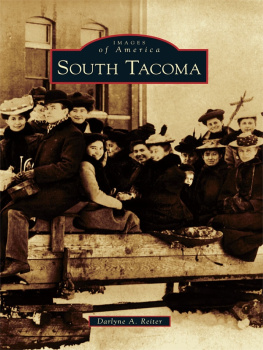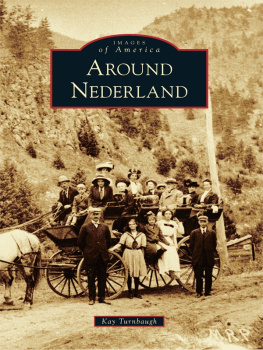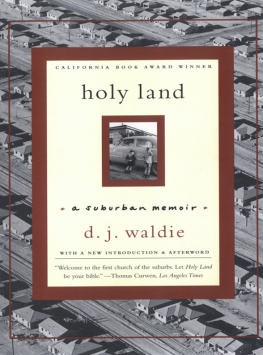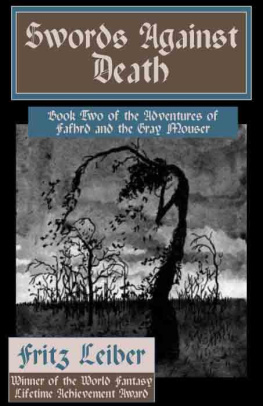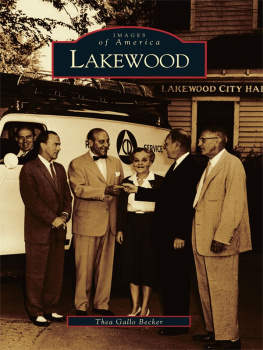
IMAGES
of Modern America
LAKEWOOD
ON THE FRONT COVER: Clockwise from top:
W Line bridge over West Sixth Avenue under construction (Authors collection; see )
ON THE BACK COVER: From left to right:
The old red barn under construction at Lakewood Heritage Center in 1997 (Authors collection; see )
IMAGES
of Modern America
LAKEWOOD
Robert and Kristen Autobee

Copyright 2015 by Robert and Kristen Autobee
ISBN 978-1-4671-3398-2
Ebook ISBN 9781439654439
Published by Arcadia Publishing
Charleston, South Carolina
Library of Congress Control Number: 2015950704
For all general information, please contact Arcadia Publishing:
Telephone 843-853-2070
Fax 843-853-0044
E-mail
For customer service and orders:
Toll-Free 1-888-313-2665
Visit us on the Internet at www.arcadiapublishing.com
To Bill Marino, a one-man assault on complacency
CONTENTS
ACKNOWLEDGMENTS
In the city we call home, we are lucky to count many friends. We would like to thank Elizabeth Nosek and Lyle Miller for their review and comments. The authors also acknowledge Jeff Murray, Katy Lewis, Susan Martin, and Kit Lammers of the City of Lakewood for keeping a good watch over the citys treasures. Thank you photographers Reed Weimer and Corky Scholl for keeping all of metro Denvers neon signs bright. Our gratitude goes Colorado Community Media, owner of the Sentinel newspaper, for the use of its images. Special thanks to Steve Davis of the Lakewood Police Department and Marian Metsopoulos of the Lakewood Historical Society, who were enthusiastic about finding photographs. Lastly, we could not write any history without the librarians at the Lakewood Library and the Denver Public Library Western History Department. They are always resourceful and patient, no matter how many volumes of unindexed photographs and newspapers we request.
Unless otherwise noted, images are from the collection of the authors.
INTRODUCTION
Lakewood, Colorado, was a name on a mapbut not a cityfor more than 80 years. From the 1889 plat of farmland named Lakewood to Jefferson Citys incorporation in 1969 to Belmar, an early-21st-century commercial development, the citys name and identity have often been afterthoughts.
Starting in a general location west of Sheridan Boulevard and along West Colfax Avenue, the name Lakewood traveled west by the early 20th century. Along the way, the first post office at Thirteenth Avenue and Brentwood Street, a general store at the intersection of todays West Colfax Avenue and Carr Street, and Jefferson Countys first telephone exchange all carried the name Lakewood. By the 1930s, the countys leading newspaper, the East Jefferson Sentinel, proclaimed the intersection West Colfax Avenue and Wadsworth Boulevard downtown Lakewood. The occasional feed store and diner dotting the surrounding pastures and cottonwood groves symbolized urban Lakewood during the 1930s. Similar to other small towns, residents made a special trip to view the installation of the busy corners new traffic light in the early 1940s. By 1947, some 36 business between modern day Jay and Kipling Streets used Lakewood in their name. Of these, 29 were on West Colfax Avenue.
The 1950s were good to Lakewood. The economy was booming, and many of its residents seriously considered incorporating as a city. Around West Colfax Avenue and Carr Street, 60 independent shop owners referred to their collective of freestanding buildings and small strip malls as the Heart of Lakewood. By 1960, newspaper ads for the new Westland Shopping Center displayed an ignorance of government and geography by referring to itself as downtown Jefferson County.
By the decades end, a majority of residents campaigned to incorporate and finally settle the question of Where is Lakewood? In 1969, a crime wave and a boom in the construction of suburban tract homes were the reasons why people in the neighboring communities of Lakewood and Wheat Ridge seriously considered incorporating as Colorados largest city (in square miles). At the last minute, Wheat Ridge decided it had a more unified identity than its neighbor to the south did, and the two communities parted amicably.
Lakewood voters went to the polls three times in 1969. As proof of a civic identity crisis, modern Lakewood incorporated as Jefferson City in June. The former Jefferson Sentinel newspaper quickly changed its masthead to the Jefferson City Sentinel, and its Letters to the Editor section was packed with comments against the choice of Jefferson City. The paper also contained reports of the citys division into wards and new voting precincts and who was running to be the first mayor and city council. Voters returned to the polls in August and elected James Richey as their first mayor. Colorados constitution required cities to hold elections in November of odd-numbered years. Three months later, Jefferson Citys voters re-elected Richey and the city council and decided the first ballot issuewhat will we call ourselves? The answer?Lakewood, of course. And the newspaper that announced the results the following week?the Lakewood Sentinel.
Who was a typical resident of this new city? Statistics from 1970 indicate he or she was middle-to-upper-middle class; owned a home valued between $10,000 and $12,000, and of European American heritage. African Americans were virtually nonexistent in Lakewood. The State of Colorado Planning Office found that only one-tenth of one percent of the countys population was African American. The Denver Federal Center, the citys biggest employer, counted 500 African American employees. And, according to the Lakewood Sentinel in February 1970, only 15 lived in Jefferson County. Over the following decades, the communitys homogeneity began to fade and new ethnicities made Lakewood their home. In 2013, European Americans still comprised almost 70 percent of the population, with Hispanics totaling 22 percent, followed by Asians at 3 percent and African Americans at 1.5 percent (US Census Bureau, http://quickfacts.census.gov/qfd/states/08/0843000.html).
For students of American history, or for those who were not around in 1970, Lakewood and the rest of the nation was a much different place. A divisive war, social unrest, and political scandal played out on television each night. By the mid-1970s, a population tired of infighting and continually reminded of the nations upcoming 200th birthday looked to the Bicentennial celebrations as a time to heal. Pre-incorporation Lakewood had no traditions of celebration (i.e., Memorial Day and Fourth of July parades) for a community as a whole to get together. The Bicentennial year launched local events like Lakewood on Parade that continue to this day. Subsequent to Lakewood on Parade, city parties like Cider Days, held every October, attempt to recreate an early-20th-century pastoral Lakewood of orchards and dairies.
Lakewood, Colorado, will reach its 50th anniversary as a city in 2019. This examination of the last five decades is the first book about a Colorado city in Arcadia Publishings Images of Modern America series. This series recalls a communitys or subjects recent past from the 1960s living color days to the present. Fifty years ago, the technology behind photography and television was expanding. The three (yes, three) television networks announced before each program if the following was in color. The majority of Americans still watched Bonanza, Gunsmoke, and The Dating Game on black and white sets.
Next page



